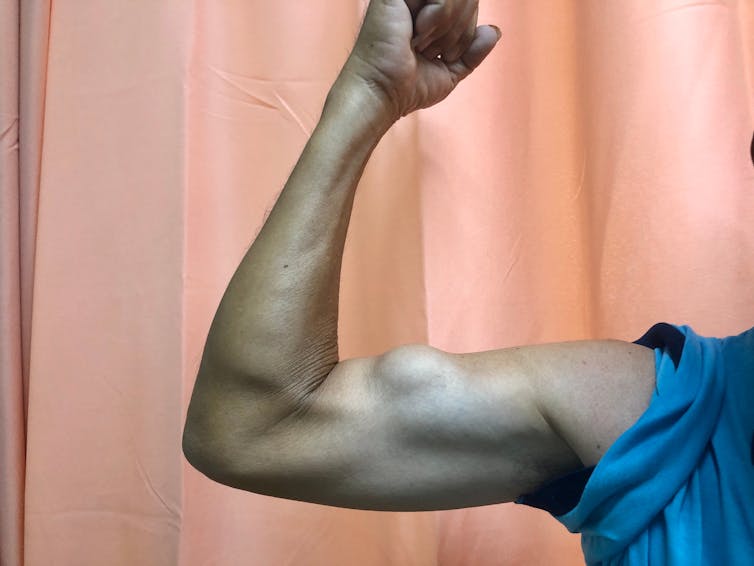Muscles are biological powerhouses, capable of truly incredible feats. You only need to look at the world’s strongest man, capable of dead lifting over 500kg, to see what they can accomplish.
While our muscles are capable of performing monumental tasks, asking them to do this can raise the risk of them tearing. Watch any episode of World’s Strongest Man, and you’ll see what I mean.
But it isn’t just strongmen and powerlifters who may experience this problem. Even the average person can be at risk of a muscle tear, from playing sport or simple day-to-day habits – though some muscles are more prone to injury than others.
Upper limb
Our biceps brachii is a muscle of twos. The name itself refers to it being the “two-headed” muscle of the arm – one head is long, the other short.
The bicep is an important muscle in flexing the forearm at the elbow, as anyone who spends their time doing curls at the gym can tell you. But this isn’t its only role. Biceps also makes it possible to rotate our hands and forearms so that we can perform a range of simple tasks – such as holding a bowl of soup in our palms.
The narrow tendon of the long biceps head makes it the easiest part to tear. In elderly people, a tear can often happen without much force. This is because tendons typically weaken with age. Even something as simple as pulling up a stubborn root vegetable in the garden can cause a tear.
When the long biceps head tears, the arm can feel like it “pops”. What is most noticeable afterwards is the odd appearance – a bulge in the upper part of the arm that makes it look like it belongs to Popeye. This injury is even called a “Popeye deformity”.
A biceps tear won’t heal by itself, so in young patients and athletes, surgery will be required. Luckily, since the short head remains intact to shoulder the burden, surgery is not often needed in elderly patients.

Other muscles that may tear from too much strain are the pectoralis majors, or pecs – the chest’s largest muscles. These muscles are capable of many different actions, such as flexing the arms and bringing them together. The pecs make a press up possible, making it an ideal exercise to train them.
Many fitness enthusiasts want strong and prominent pecs, and may make the mistake of loading up too much onto their weights. Doing so puts the muscle under huge stress.
If this muscle tears, you won’t miss it. There will be an obvious bulge as well as visible bruising afterwards. Surgery will be required to reattach it.
Lower limb
The hamstrings are one of the more commonly damaged groups of lower limb muscles. The hamstrings are located at the back of the thigh and help to bend the knee, while also extending the hips.
Hamstring tears are often caused by overstretching, particularly when the knee is straightened and the hip flexed out in front – like when a rugby player takes a kick, or in jumping over a hurdle.
For the average person, hamstring injuries typically happen when running – particularly as the front leg swings through. It may also happen while performing lunges, or leaping. Acute pain in the back of the thigh is noted. If this muscle tears, the loss of power in the leg will make walking difficult.
Sports such as squash or tennis, where you constantly change direction, can put other leg structures at risk of tearing. This is due to pushing forcefully off the ground to break into a run.
A common injury in these sports is rupture of the Achilles tendon. This is no mean feat – it’s the thickest tendon in the body, attaching your calf muscles to your heel.
If it goes, again a distinct pop in your calf is noted – sometimes like someone has kicked you. In most instances there’s pain. You’ll also experience difficulty in walking and be unable to stand on tiptoe – which is the calf’s main function.
Sometime Achilles tears are managed surgically, but in other cases the leg and foot are placed in a cast or rigid boot so that the tendon can repair itself.
How to prevent muscle tears
Taking care of your muscles and tendons during exercise is important. You should especially take care when lifting weights and use correct form. It’s important to not overload weights initially, and instead add on weight slowly according to your ability.
Take five to ten minutes at the start and end of each workout to warm up and cool down the muscles you’ve exercised. A mixture of gentle aerobic, balancing and strength exercises appears to be best. Interestingly, the effect of stretching appears unclear.
If you’re experiencing pain, don’t ignore it. This is your body saying something is wrong.
Certain factors can also increase risk of muscle tears. Tendons tend to wear thinner when taking certain medications – such as ciprofloxacin (an antibiotic), as well as steroids used for instance to treat asthma and inflammatory bowel disease. Anabolic steroids taken against medical advice to enhance muscle mass can actually increase risk of muscles tearing.
Repairing a muscle or tendon is possible, but it’s much easier to safeguard them so they don’t tear in the first place. Warm them up, cool them down – and pay attention to how, and how much, you lift.

